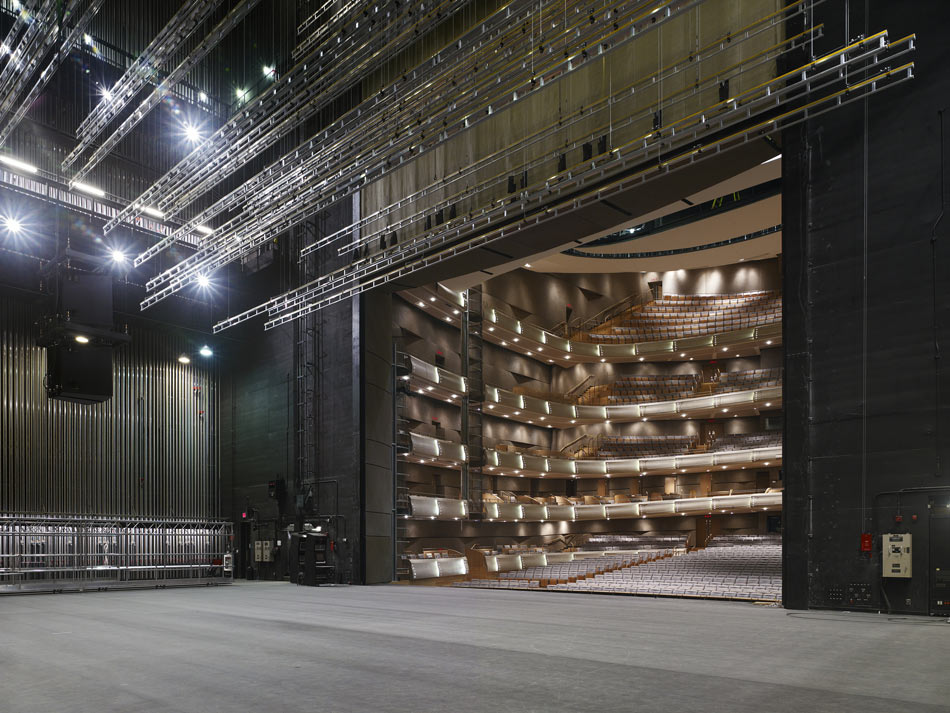Some Free (Theatre) Advice

A stage is more like an industrial work area, where equipment moves and changes frequently. Beyond the “fourth wall” the audience sits in elegant comfort. The Four Seasons Center for the Performing Arts, Toronto, Canada.Photography by Tim Griffith
Welcome to the first issue of the new digital edition of ASTC:Notes. Tell your friends and colleagues. If you haven’t already, please sign up to receive the newsletter here.
For more than 30 years the American Society of Theatre Consultants has championed the need for professional consultants to be part of the design team for assembly spaces. ASTC members consult on every type of performance venue, from traditional theatres to cruise ships and from music halls to houses of worship. As professional theatre planners and consultants, ASTC members are uniquely qualified to assist architects, engineers, owners and users to design great entertainment and assembly spaces. In addition, members of ASTC frequently speak at industry conferences, are involved in the development of codes that affect assembly spaces, and write articles for a wide variety of industry publications.
This new digital edition of our newsletter will provide current, in-depth articles, and will also provide a link to previous ASTC Newsletters where readers can find a wide variety of previous articles with topics ranging from generalized planning advice to detailed equipment design. This new format allows us to provide timeless advice on planning and design while also providing the opportunity for members to update articles to reflect changes in technology and design practice. An archive of past newsletters can be found at: theatreconsultants.org/newsletters-1/. Our goal is simple: to demonstrate that members of ASTC help create great performance spaces while dispensing valuable insights.
Theatres and similar performance spaces are some of the most complicated facilities architects will design. There are few instances of “one-size-fits-all” or cookie-cutter designs which are truly responsive. Each space must respond to the needs of the users, the audience and the producing company for years and likely decades. The code issues are complicated and very specialized. If you consider the potential conflicts among audience sightlines, accessibility, good acoustics, circulation of audiences and their comfort, all while trying to create the right atmosphere in the auditorium, the issues can be daunting. Budgets are almost always front and center. On top of all this, the stage and surrounding areas are also part of a factory or “machine” that may be adapted for every event; sometimes shows are a “one-off” and in other cases a multi-year run. In short, most performance venues must be attractive, comfortable, flexible factories. An ASTC theatre consultant has the experience and knowledge to work with owners and design team to come up with solutions for all of these and other challenges.
ASTC members agree that the sooner a consultant is involved in a project, the more likely it is to come in on budget and meet the project goals. Many projects are delayed or even derailed because they start with an inadequate program that does not match the intended budget. Engaging a theatre consultant after the major design and budget decisions are final makes it more difficult to solve what can become serious challenges. By and large, ASTC members consider the entire performance space in a holistic approach instead of serving as a specialty equipment specifier.
The design of a performance space is best accomplished when many talents collaborate. A complete Architect/Engineer Design Team that includes an ASTC Theatre Consultant as well as the Owner / User group is the best way to approach a project. If you have an idea or burning theatre design-related topic on your mind, please drop us a line at newsletter@theatreconsultants.org.
Thank you for your time and interest.
By Paul G. Sanow, ASTC
Click to go to “ASTC:Notes Fall 2015” newsletter for all article recaps


